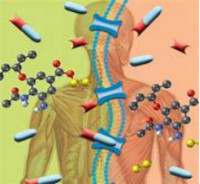Acetylation and Physicochemical Properties of Ampelocissus africana (Wild Cassava Tuber) Starch for Enhanced Drug Delivery http://www.doi.org/10.26538/tjnpr/v7i7.4
Main Article Content
Abstract
Ampelocissus africana (wild cassava tuber) is a starch-rich tropical plant that has been used as a source of diet by humans for several years, particularly in some parts of Africa during times of famine. The stalk and foliage are used to treat many ailments. This research aims to extract and modify starch from wild cassava tuber for drug delivery applications. The starch was extracted and modified by acetylation reaction. The physicochemical properties of the resultant starch was evaluated following standard procedures. The isolated starch was odourless and tasteless, with a faint ash-off-white colour. The iodine test indicated a starch content of 10.12%. Scanning electron microscope (SEM) analysis revealed that the starch was globular and oval. Thermogravimetric analysis (TGA) result showed that the modified starch exhibited a decrease in thermal stability. The range of acetyl content and degree of substitution (DS) achieved in this study were 0.39% to 6.47% and 0.02 to 0.26, respectively. The swelling power of the modified starch tended to increase
with an increase in DS. The Fourier Transform Infra-Red (FTIR) spectra indicated the presence of four significant absorption peaks: OH, C-H, C-O, and C═O, which signified the presence of the acetyl group in the starch. The findings revealed that the modified wild cassava tubers starch could be a potential excipient for enhanced drug delivery applications.
Downloads
Article Details

This work is licensed under a Creative Commons Attribution-NonCommercial-NoDerivatives 4.0 International License.
References
Vishwanath DG. Chemical Modification of Natural Polymer For Pharmaceutical Applications. PhD Synopsis, Swami Ramanand Teerth Marathwada University, Vishnupuri, Nanded-431 606. 2017; 606:1-10.
Kaushik K, Sharma RB, Agarwal S. Natural Polymers and Their Applications. Int J Pharm Sci Rev Res. 2016; 37(2):30- 36.
Alcázar-Alay SC, Angela M, Meireles A. Physicochemical Properties, Modifications and Applications of Starches From Different Botanical Sources. Food Sci Technol. 2015; 35(2):215-236.
Wang S, Wang X, Chen S. Global Value Chains and Carbon Emission Reduction in Developing Countries: Does Industrial Upgrading Matters?. Environ Impact Assess Rev. 2022; 97:106895.
Usman N, Agwamba E, Hassan LG, Almustapha NM, Achor M. Extraction and Characterization of Cassava, Potato, and Mango Starches. Caliph J Sci Technol. 2022; 4(2):221-230.
Brien SO, Wang Y, Vervaet C, Paul J. Starch Phosphates Prepared By Reactive Extrusion As A Sustained Release Agent. Carbohydr Polym. 2009; 76(4):557-566.
Wang YJ and Wang L. Characterization Of Acetylated Waxy Maize Starches Prepared Under Catalysis By Different Alkali And Alkaline-Earth Hydroxides. Starch 2002; 54(1):25-30.
Berski W, Ptaszek A, Ptaszek P, Ziobro R, Kowalski G, Grzesik M, Achremowicz B. Pasting And Rheological Properties Of Oat Starch And Its Derivatives. Carbohydr Polym. 2011; 83(2):665-671.
Copeland L, Blazek J, Salman H, Tang MC. Form And Functionality Of Starch. Food Hydrocoll. 2009; 23(6):1527- 1534.
Mohammed KG. Modified Starch And Its Potentials As Excipient In Pharmaceutical Formulations. Nov Appr Drug Des Dev. 2017; 1(1):1-4.
Mulhbacher J, Ispas-Szabo P, Lenaerts V, Mateescu MA. Crosslinked High Amylose Starch Derivatives As Matrices For Controlled Release Of High Drug Loadings. J Cont Rel. 2001; 76(1–2):51-58.
Das AB, Singh G, Singh S, Riar CS. Effect Of Acetylation And Dual Modification On Physico-Chemical, Rheological,and Morphological Characteristics of Sweet Potato (Ipomoea batatas) Starch. Carbohydr Polym. 2010; 80(3):725-732.
Association of Official Agricultural Chemists (AOAC). Official Method 996.11 Starch Total 32.2.05A. 2021.
Pérez E, Martínez A, Teijón C, Teijón JM, Blanco MD. Bioresponsive Nanohydrogels Based OnHeaa and Nipa For Poorly Soluble Drugs Delivery. Int J Pharm. 2014; 470(1- 2):107-119.
Kim SJ, Park SJ, Kim SI. Swelling Behavior Of Interpenetrating Polymer Network Hydrogels Composed Of Poly Vinyl Alcohol And Chitosan. React Funct Polym. 2003; 55(1):53-59.
British Pharmacopocia 2021 Method for Tests and Determination of Iodine. 2002. 2 p.
Rahim A, Kadir S, Jusman. The influence degree of substitution on the physicochemical properties of acetylated arenga starches. Int Food Res J. 2017; 24(1):102-107.
Aminu N, Chan S-Y, Yam M-F, Toh S-M. A Dual-Action Chitosan-Based Nanogel System of Triclosan And Fl Urbiprofen For Localised Treatment of Periodontitis. Int J Pharm. 2019; 570:118659.
Singh J, Kaur L, Mccarthy OJ. Factors Influencing The Physico-chemical, Morphological, Thermal, and Rheological Properties Of Some Chemically Modified Starches For Food Applications - A Review. Food Hydrocoll. 2007; 21:1-22.
Ayucitra A. Preparation and Characterisationof Acetylated Corn Starches. Int J Chem Eng Applic. 2012; 3(3):156-159.
Aminu N, Chan S-Y, Mumuni MA, Umar NM, Tanko N, Zauro SA, Aminu A, Toh S-M. Physicochemical Compatibility Studies Of Triclosan And Flurbiprofen With Excipients Of Pharmaceutical Formulation Using Binary, Ternary, And Multi-Combination Approach. Fut J Pharm
Sci. 2021; 7:1


